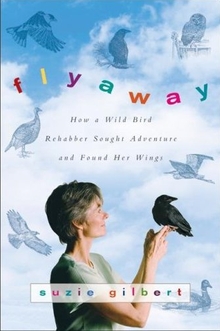Reviewed by Grant McCreary on September 18th, 2009.
As birders, we usually see birds as they are meant to be: wild and healthy. But not all birds are that fortunate. There are always the injured, the sick, and the abandoned. It has been this way for as long as there have been birds, but they’ve still managed all right. But now something has changed the equation. That would be us. Thanks to humans, there are now more injured and sick birds than ever.
But thankfully, there are also those like Suzie Gilbert, wildlife rehabilitators who take in these animals and try to help them so that they can be released back into the wild. In Flyaway, Gilbert describes how she came to be a rehabber, tells of many birds whose lives she changed, and how her life was changed in turn.
As you can imagine, anyone who works with birds, or any other animal, has some good stories. That is definitely the case here. One rehabbed and released crow virtually became a family member until it was ready to strike out on its own. It played with the kids and even the dog. I know crows are smart, but it still surprised me to find out that this one learned how to lock unsuspecting people inside their yard shed. Gilbert’s husband didn’t even believe that one until he volunteered to enter the shed himself. And sure enough, the crow seemed to take perverse pleasure as he again locked someone in the shed.
Every single bird that came through had a story, and seemingly its own distinct personality. Still, this could have become a very boring read, where the reader is detached from what they are reading. Luckily, that is not the case here. The author clearly has passion for these creatures, and that easily comes through the pages. But her writing is also easily relatable and, at times, extremely funny. After all, anyone who mentions a Weird Al Yankovic song has to be amusing!
This is all the more important because rehabbing is not all fun and games. Some birds don’t make it, and the author doesn’t shy away from talking about some tragic cases. There are some really heartbreaking situations here. Some were accidents, or otherwise just the way things go. But others were caused by people, directly or indirectly, maliciously or carelessly. Like the author, I just don’t understand some people, like the driver who intentionally swerved to hit a goose or cat owners who let their pets outside (or at least those who continue to do so after presented with the evidence of the harm that they cause to wildlife, as well as the harm that can come to the cats themselves). Speaking of which, the chapter on cats is probably the best appeal for keeping them indoors that I have ever read. It stunned me, and continues to do so.
So, given all of the heartache and hard work, why would anyone want to be a rehabber? Apparently, the successes are worth it:
We clean, feed, study, attend conferences, amass arcane knowledge, and learn to handle the creatures who fear us. Our triumph is to accept an injured wild animal, treat its injuries, carefully learn each one of its quirks and preferences, help it heal, and let it go. If things go according to plan, we will never see it again.
Somehow, this is enough.
Some very nice black-and-white drawings of birds accompany the text. The only real complaint that I have about the book is that these drawings are not labeled as to the species shown. Birders won’t have any problem recognizing them, but they would help non-birders. Granted, the identities can be inferred based upon the subject of the surrounding text, but labeling couldn’t hurt.
Recommendation
I suppose that I knew intellectually how tough it is to be a rehabber. But it never sank in until I read Flyaway. But it also has its rewards, and it is a service that is vitally needed. This insight into a different kind of human/bird interaction is enough to recommend this book to all birders. However, that’s not the only reason to read this book, nor is it just for birders. It is a great story, and very well told.
Everyone needs to know what to do when you find injured or seemingly abandoned birds. Suzie Gilbert tells everything you need to know over at 10,000 Birds in Wild Bird Rescue 101.
To find your local rehabilitator, contact your State Department of Environmental Conservation or Protection and ask for a list of rehabilitators or sanctuaries, or check out the National Wildlife Rehabilitators Association or International Wildlife Rehabilitation Council.
Disclosure: I get a small commission for purchases made through links in this post.
Disclosure: The item reviewed here was a complementary review copy provided by the publisher. But the opinion expressed here is my own, it has not been influenced in any way.



In the past I have really enjoyed books about people who work with or take care of animals, so this book really appeals to me. I’m interested especially in the part about the effect that cats have on wildlife. I guess that’s just one more reason to be happy that I have an indoor cat. 🙂
Gilbert definitely doesn’t shy away from showing what cats can do to birds. It’s an issue that she is obviously passionate about.
From what you said, you should really enjoy Flyaway.
[…] birds. If you’d like to learn more about what rehabbers do, I highly recommend the book Flyaway: How A Wild Bird Rehabber Sought Adventure and Found Her Wings, by Suzie Gilbert. Tags: bird rehab If you enjoyed this post and would like to receive updates […]